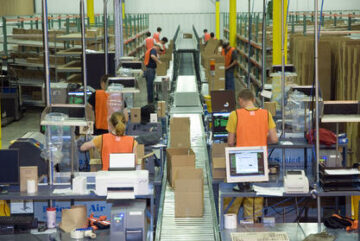This is an update of a previously published blog on warehouse change management. With the explosion of technology on the warehouse floor and the increasing use of robots and other warehouse automation, work processes are changing. To achieve the service and cost benefits you expect from technology investments, associates must embrace new ways of working. But how do you get them to do that?
Well, we’ve got a story.
Back when in-person logistics conferences were common, KANE team members attended a conference that featured a talk by an industrial engineer. The subject: adapting to changing work practices in the warehouse.
 With him at the podium was a friend he called “Roger.” It was one of those rubber blow-up props in the shape of a person, which has significant weight concentrated at its base to keep it anchored. The speaker continually grabbed Roger by the shoulders and tried to push him in the direction he wanted him to go, but Roger kept bouncing right back to his original spot. Eventually, the speaker picked Roger up and, together, they travelled quickly and easily to the new spot.
With him at the podium was a friend he called “Roger.” It was one of those rubber blow-up props in the shape of a person, which has significant weight concentrated at its base to keep it anchored. The speaker continually grabbed Roger by the shoulders and tried to push him in the direction he wanted him to go, but Roger kept bouncing right back to his original spot. Eventually, the speaker picked Roger up and, together, they travelled quickly and easily to the new spot.
The moral of the story: warehouse change is hard enough, and when you try to force compliance on warehouse associates without their involvement, it becomes even harder. Better to jointly discuss the new direction and then travel there together. That’s a good way to think about gaining associate support for lean quality programs and other improvement initiatives.
Warehouse Change Management: An Example
When KANE faced the challenge of redesigning a high-volume, cross dock facility, we leveraged an empowered workforce to solve this problem.
We once operated a 24,000-square-foot warehouse. Pretty small, but in some ways the size helped since we had less distance to travel and had to be creative to navigate our tight quarters. Lack of space had played a huge part in just about every design and process decision we made before the redesign. But now we were going from 50 dock doors to 84, and from 24,000 square feet to 36,000. We had some serious reengineering to do at our cross-dock facility and some aggressive business targets to meet.
Instead of gathering the usual suspects in a conference room to discuss options and hash it out, we took our challenge to the associates. We laid out our new throughput and productivity objectives and then asked for their ideas on how to get there.
Here are a few of the tools/approaches that we used to stimulate associate input on this warehouse change management project:
- We shut down the operation for 30-minutes to engage associates in an open dialogue meeting to generate ideas.
- We held focus groups to discuss the new dock layout.
- We tested new ideas, and we held meetings to discuss the results and the need to adapt if the desired results were not achieved.
Thanks to our associates’ input, we discovered that bigger isn’t always the solution to faster. We ended up holding on to many of our creative “small footprint” ideas, but introduced a few “big idea” concepts to achieve the required results. After months of planning, preparation and discussions, we implemented a dock layout change…which led to a warehouse slotting change…which led to a yard layout change.
We’re not done yet. Never will be.
But these changes alone resulted in a 6% productivity gain year over year, an accident-free environment, and, most importantly, a sense of engagement from our associates. The right 3PL culture can help.
Listening is Critical in Warehouse Change Management
Change is hard when you decide that you need to determine the new strategy and process flow, and then convince everyone else to get on board. Managing change in the warehouse becomes easier when you admit you don’t have all the answers and start listening to the people who spend their days executing the very processes you’re attempting to change.
The next time you’re faced with a major warehouse change management project, take the challenge to your team and let the ideas flow. And if you happen to run into Roger, just remember. He may seem a little stubborn at first, but once you get to know him, you’ll be absolutely amazed at the clarity and creativity of his ideas.
Source: https://www.kanelogistics.com/blog/warehouse-change-management
- Bitcoin
- blockchain
- blockchain compliance
- blockchain conference
- coinbase
- coingenius
- Consensus
- crypto conference
- crypto mining
- cryptocurrency
- decentralized
- DeFi
- Digital Assets
- ethereum
- KANE Blog
- machine learning
- non fungible token
- plato
- plato ai
- Plato Data Intelligence
- Platoblockchain
- PlatoData
- platogaming
- Polygon
- proof of stake
- Supply Chain Challenges
- W3
- Warehouse Operations
- zephyrnet










